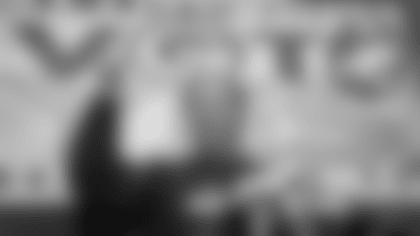Dan from Rochester, MN
Brother of Terry and Tom Rand. You helped our family greatly when Terry was inducted into the Wisconsin Basketball Coaches Association Hall of Fame. On to my question, my old, same-aged Green Bay friends were wondering what Packers players from the 1961-62 championship teams are still with us? You can limit it to the starting 22 and top subs.
Sadly, we've lost several in the last two years. I believe the only starters from those two teams still living are Boyd Dowler and Jerry Kramer, although Tom Moore started at halfback when Paul Hornung was out with an injury in 1962. Others who are still with us, as far as I know, are Gary Knafelc, starting tight end in 1959-60, and then Ron Kramer's backup in 1961-62; backup quarterback John Roach; and backup linebacker Nelson Toburen. That's based on my records and feedback from two noted pro football historians, David Neft and Ken Crippen of the Pro Football Researchers Association, who keep track of such things. I also believe there are six players still alive who played just one of the two years: Lee Folkins and Dale Hackbart from 1961; and Gary Barnes, Ed Blaine, Ron Gassert and Howie Williams from 1962. For those unfamiliar with the basketball Rands from Green Bay, they were high school stars at Green Bay East in the 1950s who went on to even bigger and better things. Terry, a 6-8 center, played with Tom Heinsohn and Bevo Francis in a national high school all-star game after his senior year at East, left Marquette University in 1956 as its all-time leading scorer and was paid this compliment by future Boston Celtics great Bill Russell: "Rand is far and away the best center I've faced in three years of college ball." Tom was 6-2 and a starting guard for Michigan State in 1958-59 when it won its first outright Big Ten championship and fell one game short of reaching the Final Four of the NCAA tournament.
Dave from Appleton, WI
Why did the Packers have home-field advantage vs. the LA Rams in the 1967 Western Conference playoff? The Rams had a better regular-season record yet the game was played in Milwaukee County Stadium rather than Lambeau Field.
Good question because the Rams finished the regular season, 11-1-2, and the Packers, 9-4-1. When New Orleans was added as a 16th team in 1967, the NFL split into four divisions of four teams each and held two conference championships before the league's title game. Going back to 1933 and the first NFL Championship Game, it was always played on a rotating basis at the home of one of the two division champions (1933-1949) and then the renamed conference champions, starting in 1950. Records had no bearing on the sites. That's why the Lambeau and Lombardi teams that won the Western championship always played the league title game at home in odd number years – 1939, '61, '65, '67 – and on the road in even number years – '36, '38, '44, '60, '62, '66. Thus, the NFL held coin flips at its annual league meeting in Honolulu in February 1967 to determine where the two conference championships would be played. Vince Lombardi participated in two flips at the meeting: He won the flip giving the Western Conference playoff to the Central champion and lost the flip to play on Sunday. That's why the Rams-Packers game was played on Saturday, the less desirable day. A year later, the Coastal champion was the home team and the Central champion the visitor based on the same predetermined rotation that was used for the league championship. As for why it was played in Milwaukee? That was Lombardi's call and he announced it in July 1967 at his press conference at the Packers' annual golf outing prior to the start of training camp. Characteristically, Lombardi didn't explain his decision, or at least I couldn't find where he was quoted. But he made it clear on other occasions that he considered the Packers a state team and Milwaukee essential to their survival. Plus, that was back when coaches and players were free on Saturday nights before road games to go eat and drink where they pleased. And not only did Lombardi like playing in Milwaukee, but I think he welcomed the opportunity to get out of Green Bay and spend Saturday nights going out in a bigger city with his wife Marie and usually close friends.
Bill from Bloomfield Hills, MI
Bit of trivia I've noticed. In 1967, the Packers won the NFL on Jan. 1 (the 1966 title game) and Dec. 31, even though there were Super Bowls after each. That was likely the only time it will ever occur in history.
Bill, if you're asking if that was the only time a team won two NFL championships in the same year, the answer is yes, although the Houston Oilers also won the first two AFL titles in the same year: on Jan. 1, 1961, and Dec. 24, 1961. If you're asking were the Packers declared NFL champions before winning the first two Super Bowls, the answer is more involved. When the Packers beat Dallas in the Ice Bowl, on Dec. 31, 1967, Tex Maule, Sports Illustrated's venerable pro football writer, wrote in his game story: "Thus, with only 13 seconds left to play, Green Bay won 21-17 to take the National Football League championship for the third straight year. No other team has been able to do that since the NFL was split into divisions." The Green Bay Press-Gazette's banner headline proclaimed: "Packer Poise Brings Third Straight." Lee Remmel, then the paper's beat reporter, wrote in his lead how the Packers won on "… a pressure-ridden race against the clock which swept them into the National Football League record book," before explaining it resulted in the Packers winning an "unprecedented third straight championship." As Maule's lead would suggest, staking claim to being the first team to win three straight since the split into divisions in 1933 was not some provincial claim made only in Green Bay or Wisconsin. Longtime Associated Press pro football writer Jack Hand's game story probably appeared in more newspapers than anyone else's and he, too, credited the Packers with winning "an unprecedented third straight National Football League playoff title." I think the entire country basically accepted that as fact. The NFL and upstart American Football League had agreed to a merger in June 1966 and the agreement included playing an AFL-NFL World Championship Game at the end of the season. It was not yet called – officially, at least – the Super Bowl. It wasn't until 1970, when the merger was completed that the two leagues were renamed conferences and the Super Bowl pitted the champions of the AFC vs. the NFC. Thus, it wasn't just the Packers who won NFL titles in the Super Bowl era. So did the Baltimore Colts in 1968 and Minnesota Vikings in 1969. But those teams lost in the AFL-NFL championship and are now viewed through the lens of history as just that: championship-game losers. No doubt had the Packers lost to Kansas City and/or Oakland in the first two AFL-NFL title games, nobody would be crediting them still today with winning an unprecedented third straight NFL championship under a playoff format. The Lombardi legacy would be painted much differently.
Eric from Milwaukee
My dad was a Shriner from Milwaukee and we often went to the Midwest Shrine Game in Milwaukee. I was but a young child then, but enjoyed seeing professional football. Around 2011, my dad showed me a roll of unused tickets that were from a very early Shrine game. My dad passed away in 2013 and I have not seen the roll since. My question is: What is the history of the Shrine Game?
The first one was played Sept. 10, 1950, at State Fair Park and the Packers beat the Baltimore Colts, 16-14. It wasn't until Aug. 5, five weeks before the game, that it was scheduled after an agreement was reached between the Packers and the Tripoli Shrine Temple. Proceeds after expenses were to be given to the Shriners hospital for crippled children. In that first game, end Al Baldwin caught a 43-yard pass from rookie quarterback Tobin Rote to set up one touchdown, a 53-yard TD pass, and a 23-yard pass to set up a Ted Fritsch field goal. The game was played at State Fair Park again in 1951, at Marquette Stadium from 1952-56 and then moved to County Stadium in 1957. It has been played at Lambeau Field since 1995. The 1950 game drew a crowd of 17,191 and in the pre-Lombardi years only once did the crowd exceed 20,000. Thereafter, the game drew big crowds except for a brief stretch in the late 1980s. In 1989, for example, attendance plummeted to 22,931.
Scott from Las Vegas, NV
I grew up in New Mexico, but my parents were from Wisconsin, as well as my relatives. Every few summers we would visit my grandparents in Cedarburg and my grandfather would take us to the Shrine Game. Somewhere near my grandparents' house was the home of Elijah Pitts. Do you have any articles on Elijah?















